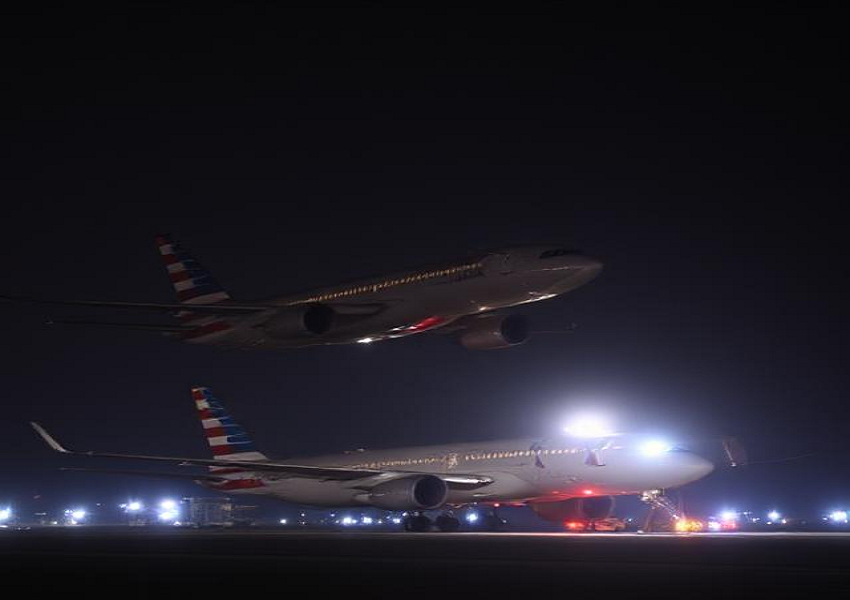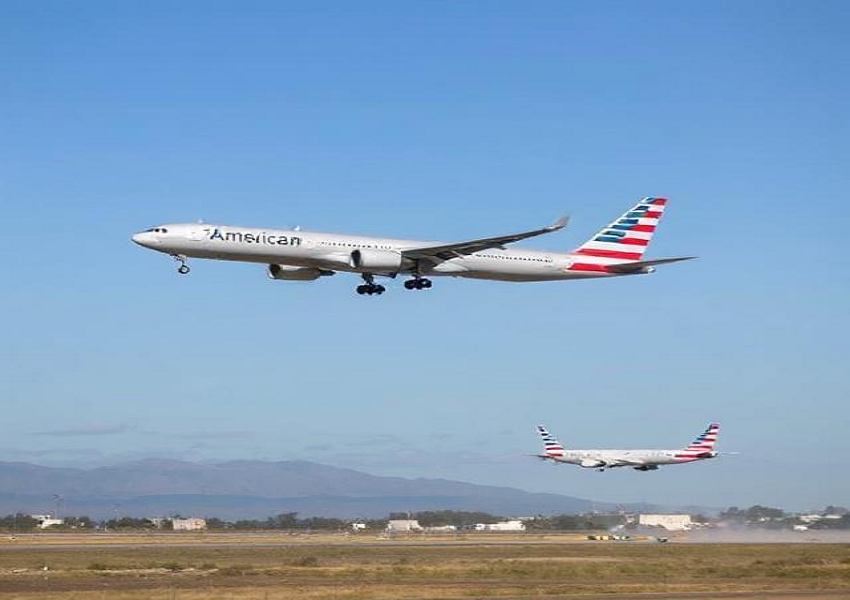
American Airlines
Table of Contents
The roar of the engines, the hum of the cabin, the familiar rhythm of travel – these are the sensations that often define the experience of flying. However, the inherent complexity of air travel means that these routines can be abruptly shattered by unforeseen circumstances. Emergency landings, a stark reality for the aviation industry, are a testament to the intricate interplay of technology, training, and human skill in the face of adversity. This article delves into the specifics of an American Airlines emergency landing, exploring the various facets of the event, from its technical causes to the critical role of crew and passengers in ensuring safety and minimizing potential harm.
Understanding the Context: The American Airlines Ecosystem:
American Airlines (AA), a major player in the global airline industry, operates a vast fleet of aircraft across a complex network of routes. A single flight, seemingly a simple journey from point A to point B, represents a culmination of years of engineering, meticulous maintenance, rigorous pilot training, and carefully crafted operational procedures. AA, like all major airlines, adheres to stringent safety regulations enforced by governmental agencies, such as the Federal Aviation Administration (FAA), to minimize risks and ensure the safety of passengers and crew.

An American Airlines Emergency Landings flight experiencing an emergency landing immediately triggers a cascade of events. The incident initiates a chain of communication, involving the flight crew, air traffic control (ATC), maintenance personnel, and emergency services. The airline’s internal crisis management teams and safety experts also become involved, working to gather information, assess the situation, and offer support. The primary focus, at every stage, remains the safety and well-being of those on board.
The Anatomy of an Emergency: The Triggering Factors:
Emergency landings can stem from a multitude of factors, broadly categorized as mechanical, weather-related, or human-related. Mechanical failures, while relatively rare due to the advanced technology and stringent maintenance schedules of modern aircraft, remain a significant concern. These failures can involve engine malfunctions, problems with critical flight control systems, hydraulic issues, or structural damage. Weather conditions can also play a crucial role. Severe turbulence, icing, and thunderstorms can compromise flight safety and necessitate a diversion to a safer airport. Human factors, including pilot error, maintenance failures, and other operational lapses, can also contribute to emergency situations.
While the specific details of a hypothetical American Airlines emergency landing are unknown for the purpose of this general discussion, it is instructive to examine the common factors that contribute to such events.
Engine Failure:
Engine malfunctions are perhaps the most dramatic of these potential triggers. A sudden loss of power, due to mechanical failure or ingestion of foreign objects, can severely impact the aircraft’s ability to maintain altitude and airspeed. Pilots are extensively trained to manage American Airlines Emergency Landings failures, including procedures for restarting the engine, diverting to a suitable airport, and executing a safe landing.
System Malfunctions:
Complex aircraft systems, including flight controls, navigation systems, and hydraulic systems, are critical for safe flight. Failures within these systems, such as loss of control surfaces or malfunctions in the autopilot, can place the aircraft at significant risk. Pilots are trained to handle various system failures, relying on backup systems and established procedures to maintain control and safely land the aircraft.
Severe Weather:
Encountering severe weather conditions, such as extreme turbulence, icing, or thunderstorms, can necessitate an emergency landing. Turbulence can destabilize the aircraft, while icing can disrupt airflow over the wings and reduce lift. Thunderstorms pose dangers of lightning strikes and strong winds. Pilots use sophisticated radar and weather data to avoid or navigate around hazardous weather conditions, but in extreme cases, a diversion to a safer airport is the only prudent option.
Medical Emergencies:
Medical American Airlines Emergency Landings involving passengers or crew can also lead to emergency landings. Sudden illnesses, injuries, or other medical crises may require immediate medical attention that cannot be provided in-flight. Pilots are trained to communicate with medical personnel and air traffic control to coordinate a landing at the nearest suitable airport where professional medical assistance can be provided.
The Protocol: A Step-by-Step Response:
An American Airlines Emergency Landings flight experiencing an emergency landing triggers a pre-defined set of procedures, meticulously developed to ensure the safety of everyone on board. The response unfolds in a structured and coordinated manner:
Declaration of Emergency
The pilot, after assessing the situation and determining that the flight is at risk, will declare an American Airlines Emergency Landings to Air Traffic Control (ATC). This declaration immediately alerts ATC to the situation and grants the flight priority for landing and other assistance. The pilot clearly communicates the nature of the American Airlines Emergency Landings, the location of the aircraft, and any other relevant information.
Communication and Coordination:
The pilot and co-pilot, in addition to communicating with ATC, will typically notify the cabin crew (flight attendants) of the situation. Effective communication between the cockpit and the cabin is essential for coordinating the response, providing information to passengers, and implementing safety procedures.
Assessment and Decision-Making
The pilots assess the severity of the problem, review available information, and make critical decisions. This includes determining the most appropriate course of action, such as continuing to the original destination, diverting to a closer airport, or making an immediate landing. They consider factors like the aircraft’s position, available fuel, weather conditions, and the nature of the American Airlines Emergency Landings.

Preparation for Landing:
The pilots will prepare the aircraft for landing. This may involve adjusting the flight path, lowering the landing gear, and configuring the aircraft for the specific runway conditions. They will also communicate with ATC regarding the planned approach and landing, coordinating with emergency services to ensure that they are in place.
Passenger Briefing
The cabin crew plays a crucial role in ensuring passenger safety. They brief the passengers about the situation, providing clear instructions on emergency procedures. This includes instructions on the use of oxygen masks, the location of emergency exits, and the proper brace position for impact. The crew’s calmness and professionalism are critical in reassuring passengers and minimizing panic.
The Landing:
The pilots execute the landing with precision and focus. They utilize all available resources and their extensive training to bring the aircraft safely to the ground. Depending on the nature of the emergency, the landing may be routine or more challenging.
Post-Landing Procedures
After the aircraft has come to a complete stop, the pilots and cabin crew implement post-landing procedures. This includes shutting down engines, disarming the aircraft’s systems, and assisting with the evacuation of passengers if necessary. Emergency services will be on hand to assess the situation, provide medical care, and provide additional support.
Investigation and Review:
Following the emergency landing, a thorough investigation will be conducted by the airline, the FAA, and potentially other relevant authorities. The investigation aims to determine the cause of the event, identify any contributing factors, and make recommendations for improving safety procedures and training.
The Human Element: Crew and Passenger Response:
While technology and procedures are critical components of an emergency landing, the human element plays an equally vital role. The actions of the flight crew and the response of the passengers can significantly impact the outcome of the situation.
Pilot Training and Expertise
Pilots undergo rigorous training and recurrent training to prepare them for a wide range of emergency scenarios. This training equips them with the knowledge, skills, and judgment necessary to make critical decisions under pressure. Their ability to remain calm, communicate effectively, and adhere to established procedures is essential for handling an American Airlines Emergency Landings landing.
Cabin Crew Preparedness
Flight attendants are also extensively trained in emergency procedures, including first aid, evacuation techniques, and passenger management. Their role is to ensure passenger safety, provide reassurance, and guide passengers through the evacuation process if it becomes necessary. Their ability to remain calm and maintain order is crucial in a crisis.
Passenger Cooperation:
Passenger cooperation is essential for a successful emergency landing. Passengers are expected to follow the instructions of the flight crew, remain calm, and assist in the evacuation if required. Their compliance with safety procedures, such as the use of seatbelts and the brace position, can significantly increase their chances of survival in the event of an impact.
Psychological Impact
The experience of an emergency landing can be deeply unsettling for both crew and passengers. Fear, anxiety, and stress are common reactions. Airlines often provide support services to help passengers and crew cope with the psychological impact of the event. This may include counseling, debriefing sessions, and other forms of assistance.
Continuous Improvement: Learning from Every Incident:
The aviation industry is characterized by a relentless pursuit of safety. Every incident, including emergency landings, is treated as an opportunity to learn and improve safety standards. The findings of investigations are shared with the industry, leading to updates in regulations, training, and aircraft design.
Technological Advancements
Continuous advancements in aircraft technology have significantly improved the safety of air travel. These advancements include improved engine reliability, enhanced flight control systems, advanced navigation systems, and more resilient aircraft structures.
Enhanced Training
Training for pilots and flight attendants is constantly evolving to reflect new risks and improve response capabilities. Simulation training, which immerses crew members in realistic emergency scenarios, is a vital component of this process.
Improved Procedures:

Airlines and regulatory agencies regularly review and update their procedures to reflect lessons learned from past incidents. This includes improvements in communication protocols, emergency response plans, and maintenance practices.
Data Analysis and Risk Management:
Airlines employ sophisticated data analysis techniques to identify potential safety risks and proactively implement mitigation strategies. This includes monitoring flight data, analyzing incident reports, and conducting safety audits.
Conclusion:
An American Airlines emergency landing, while an inherently stressful event, is a testament to the meticulous preparation, advanced technology, and unwavering dedication to safety that define modern air travel. From the pilot’s expertise to the flight attendant’s calm guidance and the passenger’s cooperation, every element plays a crucial role in ensuring the best possible outcome. Furthermore, the aviation industry’s commitment to continuous improvement, learning from every incident to enhance procedures, training, and technology, ensures that the safety of air travel continues to improve. While emergencies are unavoidable, the robust safety infrastructure and the unwavering dedication of those involved strive to make them rare and minimize the potential for harm. The next time you step aboard an American Airlines aircraft, take a moment to appreciate the complex system that keeps you safe, even when the unexpected arises.
FAQs:
Where Do American Airlines Plan Emergency Landings?
American Airlines, like all major carriers, has designated airports for emergency landings based on factors such as the aircraft’s location, type of emergency, weather conditions, and airport capabilities. These airports include:
Nearest Suitable Airport – If an in-flight emergency occurs, pilots will divert to the closest airport that can accommodate the aircraft safely, considering runway length, medical facilities, and emergency services.
Alternate Airports – For every flight plan, American Airlines designates alternate airports in case the intended destination is unavailable.
ETOPS Emergency Airports – For long-haul flights over oceans, AA follows ETOPS (Extended-range Twin-engine Operational Performance Standards) rules. This requires identifying diversion airports within a specified distance, such as:
When Do American Airlines Flights Typically Experience Emergency Landings?
Emergency landings for American Airlines, like for any airline, can happen due to various reasons such as mechanical issues, medical emergencies, or unexpected weather conditions. However, specific statistics or patterns for when these emergencies occur might not be publicly available in detail. Airlines prioritize safety, so they have protocols and training in place to handle emergencies whenever they arise.
Why Are Emergency Landings Necessary for American Airlines?
Emergency landings for American Airlines, as with any airline, are necessary primarily for passenger and crew safety. They can be required due to a variety of reasons, including mechanical problems like engine failures or cabin pressurization issues, medical emergencies among passengers or crew members, or unexpected weather conditions that may make it unsafe to continue flying. In each case, the pilot and airline operations prioritize the safety and well-being of everyone on board, which may necessitate diverting the flight to the nearest suitable airport for landing and addressing the issue promptly.





